        |
| Now recognized as the #1 Stratego site on the Internet! |
THE STRATEGO MESSAGE BOARD
SECTION 1
| I think it would be fair, and
interesting for most readers, to develop your Stratego
history before the game was taken over by MB. I can find
you a few articles, unfortunately in French, about the
original game, called l'Attaque, which was published in
France, I think, in the early twenties (may be earlier, I
must check and have not my sources at hand here). There
are absolutely no changes from this game to Stratego,
except for the names of pieces. This means that,
providing you don't use the name Stratego, the game is
now public domain. L'attaque is himself probably indebted
to the Chinese Dou Shou Qi (aka Jungle game) which uses a
similar board and capture system, but with open pieces. Original games from the twenties are hard to find, but I have a reprint of the original game made in the eighties. It's probably possible to find other such copies in France. Bruno Faidutti |
| I've taken a look at your website
and really enjoyed it. You have a nice combination
of history, strategy, & tips. It is very clean and
well presented. I especially like the opening
set-up tips. I grew up on Stratego back in the '70s and still play it occasionally today. I have two tips to share with you, for what they're worth. Ken McElhaney |
| Edward ... would you mind if I link
your page from both the Westbank Gamers site and
the Strategy Gaming site? Of course, feel free to link our pages from your website, too. Greg J. Schloesser |
| I ran across your page on
rec.games.board and I've now linked to it from the
Stratego links on www.msoworld.com Thanks for
linking to the rules page I reformatted on our
site. I really like the page. Keep up the good work. Chuck Smith |
| Just found your website during a
break at work. I'm glad that Stratego has some real
fans... I think it's neat that someone has devoted a few
pages on the web to a game which I think is rather
underrated. Thanks. Daniel Wakabayashi |
| Very nice page! Makes me want to
play some Stratego again. Brett Simmons |
| Interesting website! I give it two
paws up! In other words it has the blkdog seal of
approval. blkdog2 |
| Excellent website, Ed. Definitely a
bookmark. I especially liked the Stratego history
section. I give it the Sith 4 Star Seal of Approval. Stratego predates 1961. I believe it was invented in Holland and licensed by Milton Bradley in the '50s. I'm not sure exactly how that story goes but we have some players from Holland here, perhaps they can help you flesh that out. Also, it would be cool to break up the sample setups page and rate the setups by skill level. I must admit I went straight to this section first as I think most Stratego fans would. Most of the setups given are ok to give beginners ideas, but aren't all that great (the graphics are awesome though). Also, it is very true that the starting setup is not nearly as important as how it is played. A more detailed explanation of the use of the setups would be good (opening moves, how and when to move key pieces, contingencies, etc). Or maybe there should be an advanced section added to the Tips and Strategies page. VERY cool website Ed. I am impressed. DarthRemark |
| GREAT WEBSITE!!! If you would like any more pictures, I happen to collect the board game, and I have four different versions which you did not show. Also, Darth is right about it being a Holland game. The rights to it are still owned by a European company called Jumbo, and some of the Milton Bradley versions have both the Jumbo and MB trademarks on the box. The European Jumbo version has cylinder shaped pieces, and the newest version has no numbers on it, just the pictures. Marshal_Dave |
| I congratulate you on your website,
Ed. It's great to see this game get more exposure. If you want more history about the game you want to hook up with Stratego_Master. He is a Stratego club member who besides being a great player, knows the entire history of this fine game. This much I know: The board game originated in Holland by a company called Jumbo, then produced by Milton Bradley in the US around 1961. I believe he told me it was adapted from a war game called "Le Attaque" (The Attack) invented by a Belgium soldier during WWII. jon_lynfo |
| Hi! Thanks for your informative Stratego webpages. I have an old version of the game l'Attaque, dating from between WW1 and the end of WW2. The pieces are cardboard and stand in little metal clips. The board is very simple, with plain squares except for the rivers. My guess is that it was an economy version, produced to "War Economy" standards during WW2. The characters are all British WW1 troops and officers, and I attach a .JPG file showing their depiction. The set is in a pretty battered condition (it used to occupy hours of my childhood time), and it has become difficult to disguise the pieces as most of them have marks on the backs that make memorizing opponents' positions a bit too easy. I shall now attempt a refurbishment job. Your website was excellent in that it refreshed my memory of the rules, some of which I'd forgotten. They seem to be identical to the rules for l'Attaque as I remember them. Many thanks. John Rushby-Smith |
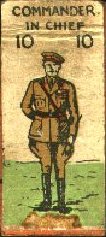 |
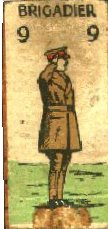 |
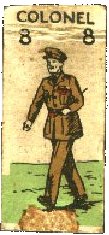 |
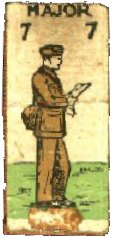 |
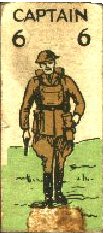 |
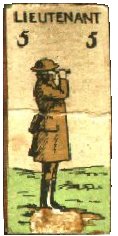 |
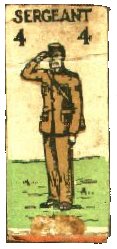 |
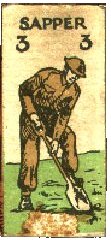 |
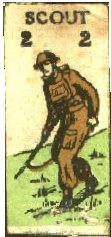 |
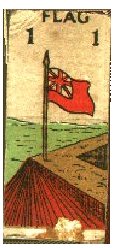 |
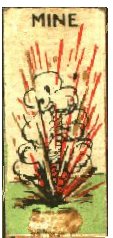 |
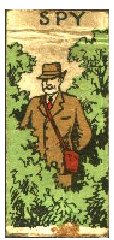 |
| Hi Ed, More on my l'Attaque pieces, as posted on your message board... On closer examination I reckon the soldiers are in WW2 uniforms, not WW1 as I first said. The give-a-ways are long trousers for the Colonel and Major, the forage caps, and the trilby for the Spy. I now remember that a school friend had an RAF version of the same game, and there was probably a naval one too. It was through l'Attaque that I came to understand military rank hierarchy. It's quite interesting that the C-in-C and Brigadier view the proceedings from an aloof distance, while it is the poor sappers and scouts that have to sneak around looking terrified! Can the game be played on the web? If so I'll have a go and see if my old wiles still hold good. John |
| Hello Ed Collins, Bravo. This is a very well done website and I applaud you for the work you have done. I think you've done an excellent job. I'm wondering if you play Stratego on-line? If so, what is your gaming name or screen name? Well I hope to see you in the Zone sometime, and play you game one day. Anyone who's committed to Stratego enough to make a beautiful website like this, is probably a good player. Jen Gregush |
| Hello Ed, What to say? I adore your website. Why? Because I am the person who started the whole Stratego Tournament stuff in Europe, just because I love the game very much. Barrage, or speed-Stratego, is invented by Marc Perriens and myself. It is also accepted this year as a part of the World Championship Stratego. In London, it will have its first World Championship Barrage. Almost everything about (the history of) Stratego you can ask me. Unfortunately, I am very busy nowadays because of work, and because a train trip from Amsterdan, Hanover, Berlin, Warschau to Kiev where a Stratego Tournament will be held. After that trip 29 July - 6 August and after the WC Stratego 24-29 in London I will be able to inform you about all the 'missing links' you search. Maybe you can send me a list with all your questions about Stratego. That would help me to give a structural reply. All the best, hope we meet one day. Where do you live in the USA? Do you come to the WC Stratego in London? I hope so! Roel Eefting |
| Hi! I was looking at your Stratego page and wanted to let you know about another early set with wooden pieces. There are two major differences from the 1961 set you have pictured: the box was smaller (about 1/2 to 1/3 the size) and the board was covered with tan vinyl with the squares printed in dark brown. There was no terrain illustrated on the board. I believe the box art was similar but scaled down (same family picture, game name spelled out on the pieces, etc.) See ya! the Mav Correct. You are describing a FINE Edition set and these were produced in 1963 - Ed |
| Very nice website, sir. I love it.
Thank you for telling us about it. Sir, come join us at the club and play. Fog of War1 |
| Thanks Ed. Your website proved
somewhat educational. I appreciated the battle formations
and comments. You sir, will be warming the hearts on a
club that strives, respects and appreciates the efforts
of someone as yourself. Thank you sir. Jerry (the only one from down under) |
| I got surprised and at same time
delighted about your web page. I live in Miami, but
was born and grew up in Panama (Central America). When I
was 12 years old I received a Stratego game (the one with
an old men in the box) which I still keep as a milestone
of my late childhood. My neighbors and I spent
hundreds of hours playing it. Even now, when I am
35 and married twice, I still have nice memories of this
game!! Would there be any chance in the future to play the game on-line? Unfortunately, my wife does not like any kind of board game, and although I would like to play it, I have no opponents!! If you know of any kind of club, association or similar, please let me know. I'm in no hurry, since I am in the process of upgrading my PC and currently no Internet access. Thanks, and keep going, you did great!! Juan |
| Edward, Just came across your website. I remember playing Stratego from morning 'til night back in the mid sixties. We would have tournaments every week and sometimes have up to twenty kids watching the two finalists. The defensive and offensive strategies were a bit different back then too. For one, the Spy would never be set up without at least a Major nearby. I didn't notice that in any of the setups you show. You have a wonderful website. It will definitely be added to my favorites list. James J. Ward |
| I checked out your Stratego page.
Pretty good. I thought the layout was pretty good, and
there is a plethora of good info. It seems like you covered just about everything there can be said about Stratego. Richard Figueroa |
| Your website looks great! I updated my Stratego page, and added
a link to your site. As for your comments about my game's AI being horrible, I agree completely. Someday I'll get back to attacking that problem again, but 10 years ago I was completely traumatized by it. :-( I haven't played the new Hasbro version. Does it have better AI? Thanks for letting me know about your page, and for your work on it! Ken McLeod |
| Hello Ed, Thanks for adding my Stratego page to your site (www.sitelinx.nl/stratego) I did the same with your page. About the history: I have played Stratego for more than 25 years now and since approximately 1980 we have the type of game similar to the one you recently purchased from someone in England... round pieces instead of cubic shaped. (see attached pic) A member of the Stratego Club Napoleon (from the site) has an Stratego game made in 1951. The company Hausseman & Hotte sold it at that time. The players are no more than a rectangular shaped flat wooden "thing" with slice in it. In the slice stood a carton picture of the Bomb or Flag etc. Note that in this early game there was no Marshal but a Lieutenant-General (and as second highest a normal General) Miners where called Mechanics. I shall make a picture of this rare board (red against green instead of blue) and mail it to you if you are interested. Luc Adriaansen |
| Ed, I like your page on Stratego! I'll definitely plan on replacing my current with your URL. You have interesting suggestions for variants. Do you think the following would work? Mercenary Stratego: Each player starts with 1 Flag and 180 points with which to hire an army. A Marshal costs 24 points, a General 18, a Colonel 13, a Major 9, a Captain 6, a Lieutenant 4, a Sergeant 3, a Miner 3, a Bomb 3, a Spy 2, and a Scout 1. Play on an enlarged board, say 10x12, in case a player needs room for more than the usual 40 pieces. The piece prices are open to change, of course. Probably one should keep records of games and try to decide which pieces are conferring advantage out of proportion to their cost, and make those pieces more expensive. This idea has been suggested with chess variants, but it hasn't caught on yet. It might have better luck with Stratego. Of course, you'd need to buy several old sets in garage sales to have enough selections. Best wishes, |
| Hello Ed, Very good website. I wish someone on our bond has the time to make our page as good as yours, but that's the reason why I write the mail. Please add: www.stratego-deutschland.de. By the way, the photos you took are from our bond tourney. You see me and some other German players. If there is anything I can do for your side, please ask me. Take Care Dieter Krapp |
| I saw your Stratego website today
and really enjoyed it. We played many hours of the
board game in my neighborhood when I was growing up.
I purchased the Accolade computer version for the PC a few years ago but I have lost my code wheel and can no longer get into the game. Do you know if the codes are posted anywhere for those of us with the games but no more access? If not, can you put the question into your "Message Board"? Thanks! Todd, I don't know of such a site but I might be able to create some type of a matrix chart so others like you who have the program but lost the code wheel can still play the game. I'll let you know. - Ed |
| Hi Ed, I just wanted to add a few comments to what John Rushby Smith had to say. I have a late 1970s version of L'Attaque which is similar to the one he has provided in JPG although the pictures are slightly more up to date (and the spy is wearing a Breton top and a berret, so I presume the French were considered the enemy). As John recalled there was an RAF version. It was called 'Aviation' and there was also a Naval version which went under the name 'Dover Patrol'. There were slight rule changes but by and large they were the same games with different flavours. I remember Dover Patrol was my favourite. There was also a game called 'Tri-Tactics' which had all three services fighting on the board at once - but it was not very playable. I can't remember who produced these games here in the UK but I think it was Gibsons. I will have to have a dig around my old games cupboard. Simon Wilcock |
| Dear Ed: I am glad that someone other than myself has taken at least some time to list the history of this game. I am currently undertaking a huge project on a booklet about 60 pages long with full color photos of Stratego. It is a strategy guide, history, etc., of the game. I assure you that Stratego as a game goes back to the late 1940s in Europe. I have photos to that effect. The oldest set I have is a set that came from Holland by way of the Netherlands. It is circa 1950. The pieces are wooden. The European sets had no numbers on them and rank silhouettes were different in appearance. The picture that you have of the early set of American Milton Bradley Wooden Stratego is NOT the first American edition. The first American Edition had the Napoleonic soldiers on it like the 1963 Fine Edition that you have correctly identified but it is as long as the 1962 set that you have pictured and there were two different inserts. The first edition box has an id tag that says "introducing the game now popular on the continent". You should know that when Milton Bradley first published this game they marketed it strictly as an ADULT game. (The side age indicator said for ADULTS.) The one insert that you have that ID's a game as "Risk" is incorrect. It is "Summit" by Milton Bradley, which the company thought would appeal to the adult Market. The other is one of the American Heritage battle games that MB published in the '60s. There are LOTS of variations on the game out there both in Europe and America as to box design and content. There was also a "Deluxe" version that was published with the "Fine" editions. If you would like, once the booket is published I will send you a copy. It will be inexpensive, only about $6.00 or $7.00. I could use any info or a copy of the game that you have pictured concerning that first computerized version with the graphics that you mentioned that were so good. I can't get this item and would like to purchase one. You are right about the "domino" effect of those first wooden pieces and they did change to plastic in '62 and it was marketed as a "family" game. The cheapo set of the man and boy playing the game on the box is from 1970. If you have any questions or would like to correspond further, please let me know. I have a lot of info about this game and its history. |
I just finished visiting your website. It was packed with a lot of info. I enjoyed playing Stratego as a kid and soon would like to play online. I am unfortunate to not have had a set, circa 1986. My longtime friend has one. We always played with his. I'm gonna search the thrift stores for a while.. they're bound to show up somewhere. e-Bay has some. I have a buddy up in the Bay Area California that enjoys the game. Do you know of anybody who ever custom made the pieces? I didn't see any photos of any and I'd like to set up one myself. Joey J Madlangbayan |
| Ed, I bought an old game in local thrift shop - which of course had no rules. And then I found you! Thank you - I thought I'd have to invent my own rules! G & K Robinson |
Hi, I would like to know how do you play the Electronic Stratego? Do you know where we could get the instructions? We have an original 1982 edition of Electronic Stratego, but no instructions sheet. Thank you! I do not have a copy of the instructions. Can anyone else help Lanny? - Ed |
Hi. Found your website. Very
interesting. However, I was surprised at the poor
defenses, which have been given names and descriptions
but are all extremely flawed.
Anyway, just some thoughts. Perhaps, some of my comments could be useful to other players. Ed Kamen |
| Ed, I just discovered your Stratego website today, and thought I'd post a few variations of the game that I sometimes play. A friend of mine and I have been playing strategy games during lunch at work for the last three or four years. Usually we vary the games quite a lot, but for the last month or so we've been playing Stratego most of the time (other games we play include chess, backgammon, Shogi, Go, The Generals, Score Four, Othello, Battleship and Risk). I've had a stratego game since the late '70s (the one with the mustached officer on the box cover). Unfortunately, I'd lost my blue #7 (a sergeant, I believe), so we weren't able to play with a full deck (so to speak). However, I recently bought another edition of the same version at a flea market and it was complete. One variation we play -- although we've not been able to do so all the way through -- is to put the two boards side by side and combine the armies. So, instead of having 40 pieces, you would have 80. Another variation is to set up one board then have a previously agreed number of pieces from the second board which can be added during the course of the game (this is somewhat similar to Ultimate Stratego, which we've also played. In fact I've tried to convince me friend we should play a game with the two regular board and the ultimate stratego board, but he balks at that idea.) We always used 10 pieces and these have included an extra Flag. Another variation we've played is to allow the Flag to move. If you get the Flag to the back row, you win (capturing your opponent's Flag is still a win as well). In another variation, Bomb movement is optional, but the Marshal cannot move. The Flag movement comes from The Generals, which I mentioned above. It was a game released in 1980 that was similar to Stratego in some respects. The pieces were similar in shape (though wider) and had images of army rank insignia inscribed on them. The five star general was the highest piece and could only be captured by one of the two agents. The agent, in turn could only be captured by one of the privates. The goal was to capture your opponent's Flag or to get your Flag to your opponent's back row. There were no Bombs, nor were there any lakes to go around. The key feature of The Generals was the "electronic arbiter" which would "decide" which piece won a battle. When one piece attacked another, both were placed in a small inset to one side of the board. The four lights, two on each side, would flash back and forth until one side lit up with "battle winner" or "victory". If the latter, it meant the Flag was captured and it would play taps. Neither side revealed the identity of their piece, although some deductions could be made. How did the arbiter work? A series of protrusions on the bottom of the pieces would depress knobs in the unit. I like that aspect of the game-- that you can't be sure of the opponent's piece's rank. Unfortunately, you can't do that in Stratego. At least one side would have to know what the other side had. At any rate, I just thought I'd share the above Stratego variations with you. And if you should happen to have an extra blue Sergeant from the 1970s version that you don't need, let me know. It would be nice if both my boards could be complete. By the way, I also don't care for the reversal of the numbers in the new version -- there was no point to it -- or for the stickers, for that matter. At least Ultimate Stratego's cardboard inserts won't peel off over time. Enjoy your game playing. Rick Keating |
| Ed, I love your
Stratego web page. Here are some variants, and some
strategy tips to go with them, I thought up recently
after your web page got me thinking. They have not
been play-tested. #1 - Replacements (requires two, six sided dice) Immediately after a player finishes his a move, he checks for a possible replacement by rolling two dice. Basically the dice roll corresponds to the rank of the replacement (a 2 is a General, a 3 is a Colonel, etc.). A dice roll of 10 or 11 gives no replacement. On a roll of 12 the player may replace his Spy or Marshal, players choice. (This scheme assumes you are using an older set before the numbering system was reversed a few years ago.) If there is no equivalent numbered piece in the dead pile, then no replacement is earned. Due to the bell curve of rolling two dice, most replacements will be from the lower ranks. Replacements may be kept off board for as long as a player wishes. Since your opponent will know the identity of a replacement when it is earned, it behooves a player to not immediately bring a piece on board. A replacement “pool” beside the board, with the replacement pieces facing the owning player, just like the ones on the board, is suggested. This will allow a player to play “the shell game” and mix them up, to maintain the fog of war, before he brings one on board. If available, a replacement may be brought on board immediately after it is earned. Confusing your opponent as to its rank may not be important if the ability to use it now is more important (for example: if you’ll soon lose without it). Whenever a replacement is brought on board it must be placed on the back row, closest to the player. If there is no open back row square, the earned replacement is placed in the replacement pool. Abbreviated turn sequence:
#2 - The Reserve At the beginning of the game, only set up 32 of your 40 units on the board. Choose eight mobile units to form a reserve. Place them facing you (to maintain the fog of war) off board, to the side, in a reserve “pool”. They may be brought on board the turn after your loses equal 12. Reserve units may only be placed on open back row squares. Therefore they may not be able to be brought on board all at once due to space limitations. Reserve units are brought on board after a player moves. Therefore moving a piece off the back row to make room for a reserve unit is a good tactic. You might want to leave one or two open back row squares in your initial set up. Also, you might want to leave a few units off board for a good while to keep your opponent from feeling it's safe to loiter near your back row. One suggestion for the reserve’s composition is a balanced battle group of: a General, a Colonel, a Major, a Captain, a Lieutenant, a Sergeant, a Miner and a Scout. The reserve being one quarter of your mobile forces fits well with this Napoleonic themed game. It was common in those times to have 25% of your forces on each wing, 25% in the middle, and 25% in reserve, with which to deliver the killing blow (or cover your retreat). Knowing when to commit the reserve was what separated many mediocre marshals from the great ones. Abbreviated turn sequence:
#3 - The Reserve and Replacements (requires two six sided dice) This variant combines both of the above variants. The off board “pool” is now for the reserve and replacements combined. Basically follow the rules of both previous variants with these exceptions: per replacement rules only one unit may be brought on board at a time, unless a players losses have exceeded 12, when the reserve rules kick in. Until the reserve rules kick in, a player must maintain at least eight units in his off board pool. However they don’t have to be the same eight pieces he put there when the game started. This variant is the most complicated, but more realistic. It makes Stratego more akin to intermediate level war games that deal with new forces dribbling on to the battlefield at odd times. Abbreviated turn sequence:
Michael Ward Wow, very interesting. Thanks Michael. I'm sure many others will find these variants interesting too. And thank you for your warm comments on my site. - Ed |